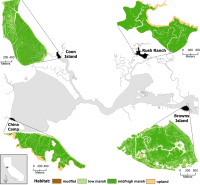SLR and wetlands in the SF Bay
 Friday, February 14, 2014 at 1:19PM
Friday, February 14, 2014 at 1:19PM  The resilience of four marshes examined in this paper.Schile, L.M., J.C. Callaway, J.T. Morris, D. Stralberg, V. T. Parker, and M. Kelly. 2014. Modeling tidal marsh distribution with sea-level rise: evaluating the role of vegetation and upland habitat in marsh resiliency. PLOS One 9(2): e88760
The resilience of four marshes examined in this paper.Schile, L.M., J.C. Callaway, J.T. Morris, D. Stralberg, V. T. Parker, and M. Kelly. 2014. Modeling tidal marsh distribution with sea-level rise: evaluating the role of vegetation and upland habitat in marsh resiliency. PLOS One 9(2): e88760
Tidal marshes maintain elevation relative to sea level through accumulation of mineral and organic matter, yet this dynamic accumulation feedback mechanism has not been modeled widely in the context of accelerated sea-level rise. Uncertainties exist about tidal marsh resiliency to accelerated sea-level rise, reduced sediment supply, reduced plant productivity under increased inundation, and limited upland habitat for marsh migration. We examined marsh resiliency under these uncertainties using the Marsh Equilibrium Model, a mechanistic, elevation-based soil cohort model, using a rich data set of plant productivity and physical properties from sites across the estuarine salinity gradient. Four tidal marshes were chosen along this gradient: two islands and two with adjacent uplands. Varying century sea-level rise (52, 100, 165, 180 cm) and suspended sediment concentrations (100%, 50%, and 25% of current concentrations), we simulated marsh accretion across vegetated elevations for 100 years, applying the results to high spatial resolution digital elevation models to quantify potential changes in marsh distributions. At low rates of sea-level rise and mid-high sediment concentrations, all marshes maintained vegetated elevations indicative of mid/high marsh habitat. With century sea-level rise at 100 and 165 cm, marshes shifted to low marsh elevations; mid/high marsh elevations were found only in former uplands. At the highest century sea-level rise and lowest sediment concentrations, the island marshes became dominated by mudflat elevations. Under the same sediment concentrations, low salinity brackish marshes containing highly productive vegetation had slower elevation loss compared to more saline sites with lower productivity. A similar trend was documented when comparing against a marsh accretion model that did not model vegetation feedbacks. Elevation predictions using the Marsh Equilibrium Model highlight the importance of including vegetation responses to sea-level rise. These results also emphasize the importance of adjacent uplands for long-term marsh survival and incorporating such areas in conservation planning efforts. Open access journal link. Pdf download.
 gis,
gis,  modeling,
modeling,  open access,
open access,  wetlands
wetlands